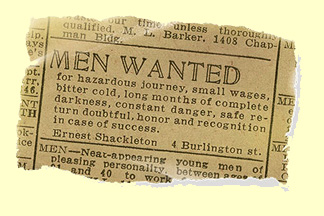
Image courtesy of John Hyatt http://johnhyattillustration.com
The advert above is often applauded as a successful advert. It is said that it generated over 5,000 applications for Shackleton’s adventure.
I learnt today that the advert may actually be a fake. Not just the illustration above which is of course fake (the English spelling of ‘honor’ is honour) but in fact that Shackleton may have placed an advert something more akin to:
“Hands wanted for long voyage in small boat. No pay, no prospects, not much pleasure.”
What the fake and the probable original share is raw honesty. Whilst none of us would suggest that charity marketing is full of lies. We should not neglect to tell our supporters exactly what the situation is. For example, if no breakthroughs have been made, we should explain why. Furthermore if we cannot explain why our service works, then we’re clearly not ready to be trusted with people’s money.
What the fake does offer though is hope. It presents the harsh challenge alongside the possible glorious outcome.
Honest challenges and hope – two more ingredients for successful fundraising communications.




